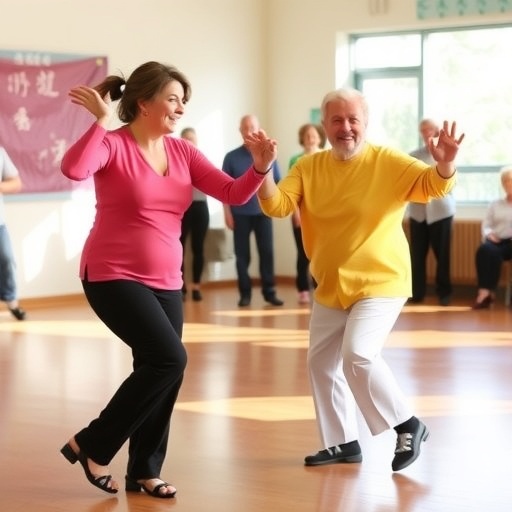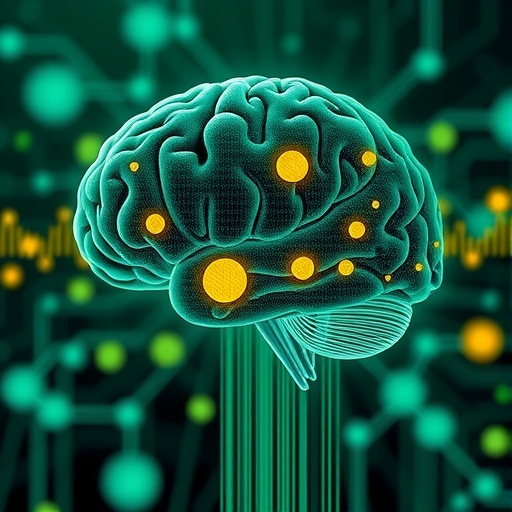In the ever-evolving landscape of health and wellness, a fresh wave of interest has arisen concerning the cognitive and physical benefits of various forms of exercise among older adults. Recent research has shed light on this critical area of study, exploring the unique and profound impact of differing movement practices. Among these, traditional disciplines like Tai Chi and Baduanjin stand in contrast to more contemporary social dances like square dance and Latin dance. A randomized controlled trial conducted by Wu and Zhang aims to unravel the nuances of these practices in terms of their efficacy in fostering not only physical strength and agility but also cognitive vitality in an aging population.
The significance of maintaining an active lifestyle in older age cannot be overstated. As individuals progress into their golden years, the risk of cognitive decline looms large. Dementia and other cognitive disorders are serious concerns that can greatly affect the quality of life. Therefore, the exploration of interventions that could mitigate these risks is crucial. Wu and Zhang’s study provides a comprehensive examination of how varying exercise regimens can serve as interventions, potentially leading to enhanced cognitive function among seniors.
Tai Chi, a centuries-old martial art practiced primarily for its health benefits, is characterized by slow, deliberate movements and deep, focused breathing. Recent studies have supported the notion that Tai Chi can improve balance, flexibility, and mental focus, offering a holistic approach to health. Wu and Zhang’s research emphasizes these dimensions, especially in older adults who may struggle with stability and strength. The study hypothesizes that these physical benefits could translate into improved cognitive function, thereby enhancing overall quality of life.
Alongside Tai Chi, Baduanjin—a traditional Chinese qigong practice consisting of eight specific movements—has garnered attention. This gentle and straightforward exercise regimen has been admired for its ability to promote relaxation while simultaneously encouraging physical stamina. Wu and Zhang draw attention to Baduanjin as a potentially valuable practice for older adults not only due to its physical attributes but also due to its meditative quality, which may bolster cognitive functions such as memory and concentration.
The study’s comparative approach involves square dance and Latin dance, both of which are social and dynamic forms of physical activity. Square dance, often considered a community-centered pastime, incorporates rhythm, teamwork, and memorization of steps. The interactive nature of square dance may have implications for social engagement, which is crucial in combating loneliness often experienced by older adults. Wu and Zhang’s analysis posits that these social aspects could further enhance the psychological benefits derived from participation in such activities.
In contrast, Latin dance offers a vibrant, expressive avenue for physical activity that often appeals to a different demographic within the older population. The study notes that Latin dance can be both exhilarating and energizing, contributing to cardiovascular fitness while simultaneously allowing participants to express themselves creatively. The joyful nature of Latin dance may provoke positive emotional responses, which can be an essential counterbalance to the challenges of aging.
Drawing upon a robust sample size, Wu and Zhang’s trial aims to assess the outcomes of these four exercise modalities in a rigorously controlled environment. Participants are not only monitored for physical changes, such as improved mobility and strength, but also for shifts in cognitive markers, including memory recall and executive function. By employing a variety of cognitive assessments alongside physical performance metrics, the researchers are positioned to draw nuanced conclusions about the interconnectedness of physical and cognitive health.
The landscape of health promotion among older adults is broad and multifaceted, yet the findings from Wu and Zhang have the potential to influence guidelines on physical activity across this demographic. In light of the ongoing global conversation surrounding healthy aging, implementing more inclusive and diverse programming could meet the varied preferences and abilities of older adults. Encouraging a mix of Tai Chi, Baduanjin, square dancing, and Latin dancing could not only enrich the lives of seniors but also instill a greater sense of community and connectedness.
Additionally, beyond individual health, promoting these forms of physical activity could alleviate some of the societal burdens posed by an aging population. With declining birth rates and an increasing proportion of elderly individuals, finding sustainable health solutions will be critical. By validating and promoting active lifestyles through the integration of enjoyable and varied forms of exercise, public health initiatives could foster healthier aging.
As the study unfolds, it is vital to consider the implications of these findings across various settings. For instance, community centers, retirement communities, and even urban parks could incorporate diverse dance and movement classes tailored for older adults. Such initiatives could lead to a multi-generational approach to fitness where the barriers of entry are minimized, fostering interaction and camaraderie among different age groups through shared physical activity.
While awaiting full results from the study, the anticipation surrounding its implications is already notable. There is a clear urgency to understand the intricacies of how dance and physical movement influence cognition and well-being. The potential life-altering benefits for older adults could not only change individual health trajectories but may also inspire communities and policymakers to prioritize engaging and accessible physical activity programs across the board.
As Wu and Zhang pave the way for further discourse, the wider implications of their research resonate deeply with contemporary understandings of health and wellness in aging populations. The findings from this trial could significantly contribute to the growing body of literature advocating for a more active lifestyle as a preventative strategy against cognitive decline, encouraging seniors to move, engage, and thrive.
With the world standing at the threshold of an unprecedented aging phenomenon, the insights derived from Wu and Zhang’s research might just herald a new chapter in geriatric health—a chapter where movement becomes a primary pillar of holistic well-being among older adults, ultimately illuminating pathways toward healthier futures for all.
Subject of Research: The effects of Tai Chi, Baduanjin, square dance, and Latin dance on cognitive and physical health in older adults.
Article Title: Comparing Tai Chi, Baduanjin, square dance, and Latin dance for cognitive and physical benefits in older adults: a randomized controlled trial.
Article References:
Wu, Z., Zhang, F. Comparing Tai Chi, Baduanjin, square dance, and Latin dance for cognitive and physical benefits in older adults: a randomized controlled trial.
Eur Geriatr Med (2025). https://doi.org/10.1007/s41999-025-01255-3
Image Credits: AI Generated
DOI: 10.1007/s41999-025-01255-3
Keywords: cognitive benefits, physical health, Tai Chi, Baduanjin, square dance, Latin dance, older adults, randomized controlled trial.
Tags: active lifestyle in golden yearsBaduanjin exercise for seniorscognitive vitality through movementDance for seniors health benefitsenhancing quality of life through exercisemitigating cognitive decline in older adultsphysical exercise for older adultsrandomized controlled trials in senior healthsocial dance benefits for elderlyTai Chi and dementia preventionTai Chi cognitive benefits for agingtraditional vs contemporary exercise for seniors





